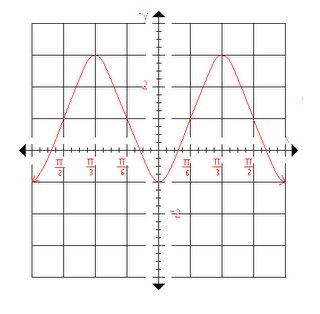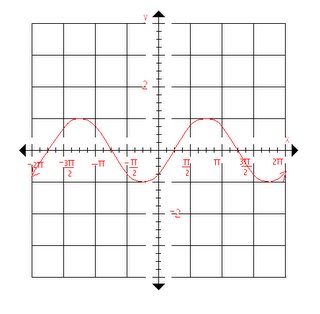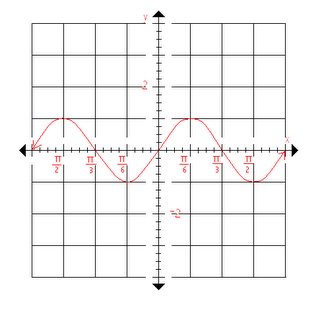Scribe Post _Graphing Trigometric Functions_
Hi, I’m Allen, and I am the scribe for today.
Today we just extended our knowledge about
how to graph trigonometric functions.
Mr. K started the class off with asking us
to graph the following trigonometric functions:
1) y=sin2x-1
2) y=2cosx+1
3) y=2sin(Πx)
2) y=2cosx+1
3) y=2sin(Πx)
~*Solutions:*~
1) y=sin2x-1
2) y=-2cosx+1
Then we had to graph 2 trigonometric functions with a
phase shift. The questions are as follows:
1) y=sin(x-(Π/4))
2) y=-cos3(x+(Π/6))
~*Solutions:*~
*The way you would graph a phase shift function is to first
draw the graph as if there was no phase shift. So the function
would look like this " y=sinx". Now since there is a -(Π/4) in
brackets beside x the entire graph will move right, NOT left
as the negative (Π/4) suggests.*
1) y=sin(x-(Π/4))
2) y=-cos3(x+(Π/6))
After that we where given a graph and was asked to give at
least 1 cos and 1 sin equation that would results in the
following graph:
~*Solutions:*~
The easiest way to solve a problem like this is to find the values
in the formula "A sin B (x-C)+D" so A, B,C and D. But first you
must choose a point to start from.
-Example1: for sin if I chose the spot where the line intersects
the y axis.-
A=2 because the graph shows the min and max is 2 units up and
2 units down.
B=4 because the graph shows that there are 4 waves in 2Π
(you find this by using the formula "period=(2Π)/B" and if
you put 4 in the result is Π/2 which is the end of 1 wave.
C=Π/8 because this is the phase shift the graph would
undergo to result in its current form if I was looking at it as
a sine value.
D=1 because the horizontal plain where the min and max are
equal occur at positive 1 on the y axis.
So the Final answer would be:
2sin4(x-(Π/8))+1
-Example2:for cos if I chose the spot where the line intersects
the y axis.-
A=-2 because the wave starts from its min where it intersects
the y axis. Which is down 2 from the horizontal plain where the
min and max are.
B=4 because the graph shows that there are 4 waves in 2Π
(you find this by using the formula "period=(2Π)/B" and if
you put 4 in the result is Π/2 which is the end of 1 wave.
(you find this by using the formula "period=(2Π)/B" and if
you put 4 in the result is Π/2 which is the end of 1 wave.
C=0 because I chose the point where the line intersects the y
axis. Which happens to be the min so no phase shift has occured
(only in the way I choose) ,resulting in a normal cos function.
D=1 because because the horizontal plain where the min and max are
equal occur at positive 1 on the y axis.
equal occur at positive 1 on the y axis.
So the Final answer would be:
y=-2cos4x+1
*Note* that these are only 2 out of a possible
infinity answers. There areinfinity answers
because each point where the wave reaches i
ts max or min has its own set of A,B,C,&D
combos and since the wave keeps going and
going ( Ill stop there because I may get fined
or something for copying energizers saying.),
but all the equations would be the same becuase they
are on the same wave!!.
Thats all for now, and now for the
moment you've been waiting for
the next scribe will be Anh!!!
And my brother choose this name
so dont get mad at me!






haha its okay..good thing I don't have work this weekend =) Anyway just wanted to let you know you have a BIG blank space that goes on and on at the bottom of your scribe post and you also forgot your title on the bottom "Scribe Post". You did a very good job.
ReplyDeleteVery cool graphs =], keep up the string of awesome blogs!
ReplyDeleteHi Allen,
ReplyDeleteIncluding your topic in your title and the first paragraph is really helpful! I imagine it might be so later on too when your classmates want to review trigometric functions.
As scubasteve mentioned, your graphs add so much to understanding!
And I appreciated your reference to the Energizer bunny!! And yes, there is a HUGE blank space at the end of your post; was that part of the Energizer analogy too? :)
Best,
Lani